A vast amount of data is created daily, presenting businesses with never-ending data analysis challenges. For instance, Statista predicts a continued increase in the volume of data created, hitting 90 zettabytes by 2022 and doubling by 2025.
Generally, data analytics help businesses make better decisions and become more efficient, besides gaining a competitive advantage. But in the face of the fast-growing volume of data, and the apparent challenges (storing, managing, analyzing), achieving these goals can be an uphill task.
For these reasons, businesses (more so analysts) must be well-versed with possible data analysis challenges to find appropriate ways to navigate them and gather the appropriate insights to inform business decisions and processes.
Below we discuss some common data analysis challenges analysts face and how they address them.
Managing vast amounts of data
A vast amount of data collected daily can become a massive mess without an automated data management solution.
Look at it this way. Data is created for every interaction across your channels – email, social, website, paid search ads, and virtual store. With time, analyzing it can get overwhelming, hindering the insights’ completeness.
However, you still need to leverage the data to obtain insightful information to boost your business growth and stay ahead of the competition.
Thus, to avoid the time-consuming and inefficient procedure, not forgetting the high risk of inaccuracy, it’s essential to use analytics tools to collect, manage, and analyze the data in real time.

1. Collecting meaningful data
With the high volume of data available for businesses, collecting meaningful data is a big challenge. Ideally, employees spend much time sifting through the data to gain insights, which can be overwhelming. Besides, it’s impossible to sort and analyze all the data in real-time, which might fail to provide accurate and relevant reports.
You can easily overcome this problem using an appropriate data analytics tool. The tool can help you collect, analyze, and provide real-time reports for better decision-making. On the same note, it reduces the time employees spend collecting and analyzing data, thereby boosting productivity.
The use of data analytics tools should also go hand in hand with employee training on effective data utilization, either through online training programs or coaching workshops.
2. Selecting the right analytics tool
Without the perfect tool for your business data analytics needs, you may be unable to conduct the data analysis efficiently and accurately.
Different analytics tools (Power BI, Tableau, RapidMiner, etc.) are available and offer varying capabilities. Besides finding software that fits your budget, you should consider other factors such as your business objectives and the solution’s scalability, integration capabilities, ability to analyze data from multiple sources, etc.
If you have a data analyst, they should be well-versed in how to select the right tool. But since the analytics landscape is changing quickly, those not conversant with modern data analytics could enroll in a refresher course such as the Tableau Data Analytics Certificate to hone their skills. Alternatively, you could consult an expert to guide you on the best tool based on your business needs.
3. Data visualization
Data requires to be presented in a format that fosters understandability. Usually, this is in the form of graphs, charts, infographics, and other visuals. Unfortunately, doing this manually, especially with extensive data, is tedious and impractical. For instance, analysts must first sift through the data to collect meaningful insights, then plug the data into formulas and represent it in charts and graphs.
The process can be time-consuming, not forgetting that the data collected might not be all-inclusive or real-time. But with appropriate visualization tools, this becomes much easier, more accurate, and relevant for prompt decision-making.
4. Data from multiple sources
Usually, data comes from multiple sources. For instance, your website, social media, email, etc., all collect data you need to consolidate when doing the analysis. However, doing this manually can be time-consuming. You might not be able to get comprehensive insights if the data size is too large to be analyzed accurately.
Software built to collect data from multiple sources is pretty reliable. It gathers all the relevant data for analysis, providing complete reports with minimal risk of errors.
5. Low-Quality Data
Inaccurate data is a major challenge in data analysis. Generally, manual data entry is prone to errors, which distort reports and influence bad decisions. Also, manual system updates threaten errors, e.g., if you update one system and forget to make corresponding changes on the other.
Fortunately, having the tools to automate the data collection process eliminates the risk of errors, guaranteeing data integrity. More so, software that supports integrations with different solutions helps enhance data quality by removing asymmetric data.
6. Data Analysis skills challenges
Another major challenge facing businesses is a shortage of professionals with the necessary analytical skills. Without in-depth knowledge of interpreting different data sets, you may be limited in the number of insights you can derive from your data.
In addition to hiring talent with data analysis skills, you should consider acquiring easy-to-use and understand software. Alternatively, you could conduct training programs to equip employees with the most up-to-date data analysis skills, especially those handling data.
7. Scaling challenges
With the rapidly increasing data volume, businesses face the challenge of scaling data analysis. Analyzing and creating meaningful reports becomes increasingly difficult as the data pile up.
This can be challenging even with analytics software, especially if the solution is not scalable. That’s why it’s important to consult before acquiring a tool to ensure it’s scalable and supports efficient data analysis as your business grows.
8. Data security
Data security is another challenge that increases as the volume of data stored increases. This calls for businesses to step up their security measures to minimize the risks of potential attacks as much as possible.
There are several ways of mitigating the risks, including; controlling access rights, encrypting data with secured login credentials, and conducting training on big data. Alternatively, you could hire cybersecurity professionals to help you monitor your systems.
9. Budget limitations
Data analysis is a cost-intensive process. It can be a costly investment, from acquiring the right tools to hiring skilled professionals and training the employees on the basics of data analysis. Again, with the high volatility of data, the managers must be proactive to secure the system and address any security threats while scaling the system to accommodate the growing volume of data.
Ideally, risk management is a small business function, and getting budget approvals to implement the strategies can be a challenge. Nonetheless, acquiring the necessary tools and expertise to leverage data analysis. So the managers must be strategic about the solution they receive and provide detailed return on investment (ROI) calculations to support the budget.
10. Lack of a data culture
The success of data analysis in a business depends on the culture. In a research paper on business intelligence, 60% of companies claimed that company culture was their biggest obstacle. However, most companies are not data-driven. They have not equipped the employees yet with the necessary knowledge on data analysis.
To overcome this challenge, it’s crucial to equip your employees to support data culture by providing the necessary training.
11. Data inaccessibility
Data collected can only benefit the business if accessible to the right people. From the analysts to the decision-makers, businesses need to make sure every key person has the right to access the data in real-time and be fully empowered with knowledge on how to analyze different data sets and use the insights.
Mainly, businesses restrict system access for security reasons. But with appropriate security safeguards, you can enhance safer and unrestricted data access for analysis and decision-making purposes.

Conclusion
With the vast amount of data created daily, businesses face the huge challenge of sifting through all the various data sets to draw valuable insights and inform business decisions. Besides the possibility of messy data due to the high volume, they also face other challenges such as collecting meaningful data, selecting the right analytics tool, data visualization, multiple-source data, low-quality data, lack of skills, scaling challenges, data security, budget limitations, lack of a data culture, and inaccessibility. Fortunately, they can overcome these challenges by investing in a suitable data analytics tool, training employees on data analysis, and stepping up their cybersecurity safeguards, among other suggested solutions.
Whether you’re a business decision-maker looking for a solution to train your staff on data analysis and overcome the above challenges, or you’re a professional desiring to further your data analysis skills and increase your competitiveness at the workplace or in the job market, we welcome you to partner with Pathstream, so we can help you fulfill your dream.
Was this helpful?
Thanks! What made it helpful?
How could we improve this post?





